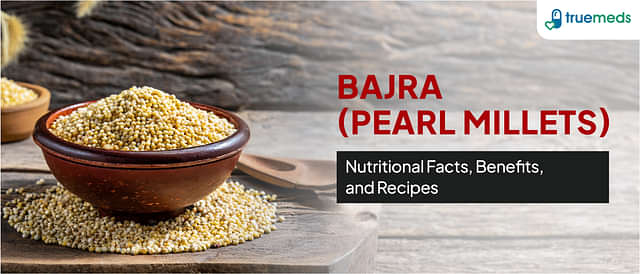Bajra (Pearl Millets): Nutritional Facts, Benefits, and Recipes
Last updated on : 15 Nov, 2024
Read time : 12 min
Bajra, also known as pearl millet, is a nutrient-dense grain that has been an integral part of Indian and African cuisines for generations. With its high fibre content, essential nutrients, and numerous health benefits, bajra is a versatile food that can be incorporated into various dishes. In this blog, we will explore the nutritional facts, health benefits, and delectable recipes of bajra, showcasing why it deserves a prominent place in your diet.
What is Bajra (Pearl Millet)?
Bajra, scientifically known as Pennisetum glaucum, is a type of millet belonging to the small-grained cereals family. This pale yellow grain is characterised by its small, round seeds. Bajra is highly valued for its ability to thrive in arid and semi-arid regions, requiring minimal water, making it a significant crop for small-scale farmers. Its cultural significance and impressive nutritional profile make it a treasured grain in many traditional cuisines.
| Did You Know: Bajra has a rich history as one of the oldest cultivated crops, dating back over 4,000 years. Initially domesticated in the Sahel region of West Africa, it spread to India and other parts of the world. Archaeological evidence suggests that bajra was a staple in ancient diets, particularly in regions like northern China and India. Its resilience to harsh climates and poor soils made it a vital crop for early agricultural societies, significantly contributing to the development of settled farming practices and multicrop agriculture. |
Nutritional Value Of Bajra (Pearl Millets)
Bajra is packed with essential nutrients, making it a valuable addition to a healthy diet. The average nutritional value of bajra per 100 g is detailed in the table below.
| Nutrient | Amount per 100 g |
| Calories | 378 kcal |
| Carbohydrates | 73.97 g |
| Dietary Fibre | 8.5 g |
| Protein | 10.67 g |
| Fat | 4.07 g |
| Vitamin B-complex | Present |
| Calcium | Present |
| Phosphorus | Present |
| Iron | Present |
| Potassium | Present |
| Magnesium | Present |
| Copper | Present |
| Manganese | Present |
| Antioxidants | Phenolic compounds, flavonoids |
How to Consume Bajra (Pearl Millets)
Bajra is a versatile ingredient that can be consumed in various forms, making it easy to incorporate into your culinary preparations. Traditionally, it is ground into flour and used to make rotis, which are served hot with ghee. Whole bajra can be used to prepare dishes like upma and khichdi, offering a nutritious twist to these classic recipes. For those with a sweet tooth, bajra can also be incorporated into delectable treats like ladoos, often paired with the goodness of jaggery. If you are looking to diversify your diet, bajra serves as a nutritious substitute for rice and wheat, providing gluten-free options suitable for individuals with gluten intolerance.
Bajra Health Benefits
Bajra is a nutritious grain that offers a wide range of health benefits. Let us delve deeper into the specific health benefits of this wholesome grain.
1. Helps Control Diabetes
One of the key benefits of bajra is its ability to help control diabetes by stabilising blood sugar levels. The high fibre content in bajra slows down the digestion of carbohydrates, preventing a rapid spike in blood glucose levels. Moreover, the magnesium present in bajra enhances insulin response, reducing insulin resistance, which is particularly beneficial for individuals with diabetes. By incorporating bajra into their diet, diabetic patients can better manage their blood sugar levels and improve overall glycaemic control.
2. Helps Keep the Heart Healthy
Bajra is an excellent choice for maintaining a healthy heart. Regular consumption of this nutritious grain can help lower total cholesterol, LDL (bad) cholesterol, triglycerides, and blood sugar levels, all of which are crucial factors in promoting heart health. The dietary fibre and essential nutrients found in bajra work together to reduce the risk of heart attacks and other cardiovascular diseases.
3. Safe For People Intolerant To Gluten
For individuals with gluten intolerance or coeliac disease, finding suitable grain options can be a challenge. Fortunately, bajra is naturally gluten-free, making it a safe and nutritious alternative. Its gluten-free nature allows it to be easily incorporated into gluten-free diets without compromising on taste or nutritional value.
4. Weight Control
If you are looking to manage your weight, bajra can be a valuable ally. The complex carbohydrates and high fibre content in bajra take longer to digest, keeping you feeling fuller for an extended period. This slow release of energy helps maintain stable energy levels throughout the day, reducing the likelihood of overeating or snacking on unhealthy foods.
5. Polycystic Ovary Syndrome
While there is limited research specifically on bajra’s direct impact on polycystic ovary syndrome (PCOS), its nutritional profile suggests potential benefits. The high fibre and magnesium content in bajra can help regulate blood sugar and insulin levels, which are often imbalanced in individuals with PCOS. Additionally, the antioxidant and anti-inflammatory properties of bajra may support overall hormonal balance and alleviate some of the symptoms associated with PCOS.
5. Improves Digestion
Bajra is an excellent source of dietary fibre, which plays a crucial role in promoting healthy digestion. The fibre in bajra helps regulate bowel movements, preventing constipation and promoting regular elimination. Moreover, the fibre acts as a prebiotic, supporting the growth and activity of beneficial gut bacteria. By nourishing the gut microbiome, bajra contributes to overall gastrointestinal health and enhances nutrient absorption.
6. Natural Detoxifier
In addition to its digestive benefits, bajra also acts as a natural detoxifier, helping to flush out toxins from the body. Its alkaline nature helps combat acidity and maintain a healthy pH balance within the body. The high fibre content in bajra aids in removing waste products and toxins from the digestive system, promoting a clean and healthy gut.
7. Increases Lung Power
Bajra, or pearl millet, is a nutritious grain that can contribute to overall health and energy levels due to its rich mineral content, including magnesium. While there is no direct evidence linking bajra to increased lung power, magnesium plays a crucial role in converting food into energy and regulating the nervous system. This can indirectly support physical performance and endurance, potentially benefiting respiratory health. The nutrient-dense profile of bajra may also help in maintaining overall well-being, which can positively impact lung function.
8. Fights Heartburn
Its high fiber content can help improve digestion and reduce symptoms of digestive disorders. Fiber aids in regulating bowel movements and promoting gut health, which may indirectly alleviate heartburn symptoms by preventing constipation and other gastrointestinal issues. Incorporating bajra into a balanced diet can support digestive well-being, which may, in turn, help manage heartburn.
9. Strengthens Bones
Bajra is an excellent source of minerals that are essential for bone health, such as phosphorus, magnesium, and zinc. Phosphorus is crucial for bone formation and repair, while magnesium helps in the absorption of calcium, a key mineral for maintaining bone density. Zinc also supports osteoblast activity, which is involved in bone formation.
10. Overcome Fatigue
Bajra is known to help overcome fatigue due to its high content of complex carbohydrates and essential minerals like magnesium. Magnesium plays a vital role in converting food into energy and regulating the nervous system. Consuming foods high in magnesium, such as bajra, can help increase energy levels and combat fatigue by ensuring that the body’s cells are adequately fueled.
11. Prevent Hair Loss
Although there is limited research indicating that bajra directly prevents hair loss, this nutrient-dense grain is rich in iron and other essential nutrients that can help prevent deficiencies associated with hair loss. Iron deficiency is a common cause of anaemia, which can lead to hair loss. Consuming bajra as part of a balanced diet may help maintain healthy hair by preventing such deficiencies and providing the necessary nutrients for hair growth.
What Are the Side Effects of Bajra (Pearl Millet)?
While bajra offers numerous health benefits, it is important to be aware of potential side effects, especially when consumed in excess.
- Bajra contains high levels of oxalates, which can contribute to the formation of kidney stones if not prepared properly.
- The presence of phytic acid in bajra may hinder the absorption of essential minerals like iron, zinc, and calcium.
- Those with digestive issues, such as irritable bowel syndrome (IBS), may experience discomfort due to bajra’s high fibre content.
- Bajra’s goitrogenic properties can potentially affect thyroid function, and its warming nature may cause bloating and flatulence, particularly during hot weather.
Four Easy Bajra Recipes for Healthy Meals
Bajra’s versatility allows it to be incorporated into a variety of dishes, offering both nutrition and flavour. Here are four simple recipes that showcase the grain’s potential.
1. Pearl Millet Porridge (Sweet/Salty)
Start your day with a nourishing and comforting Pearl Millet Porridge, which can be enjoyed in both sweet and savoury variations:
- Sweet: 1 cup pearl millet (bajra), cooked with 3 cups milk, 2 tbsp sugar, and 1/2 tsp cardamom powder until thickened (about 15-20 minutes). Serve warm, garnished with chopped nuts or raisins if desired.
- Savoury: 1 cup pearl millet (bajra), cooked with 3 cups water and 1/2 tsp salt.Add 1 cup chopped spinach or grated carrots for extra nutrition and cook for an additional 5 minutes. Serve warm, drizzled with ghee or topped with roasted seeds.
2. Bajra Roti (Flatbread)
Bajra roti, a traditional Indian flatbread, is gluten-free and rich in fibre, making it a healthy alternative to regular wheat rotis:
- Prepare the dough by combining 2 cups pearl millet (bajra) flour, 1/2 tsp salt, and about 1 cup water.
- Knead well and divide into lime-sized balls. Roll each ball into a thin round roti.
- Cook on a griddle or tava until golden brown (about 1-2 minutes on each side).
- For added flavour and nutrition, brush the rotis with ghee before serving.
3. Pearl Millet Salad
Create a refreshing and nutritious salad using cooked pearl millet as the base:
- Combine 2 cups cooked pearl millet (bajra) with 1 cup diced cucumber, 1/2 cup grated carrots, and 1/2 cup diced bell peppers.
- Add fresh herbs such as 2 tbsp chopped coriander and 1 tbsp chopped mint.
- Dress the salad with a mixture of 2 tbsp lemon juice and 1 tbsp olive oil, seasoning with salt and pepper to taste.
4. Bajra Khichidi
Bajra Khichidi is a hearty and wholesome dish that makes for a perfect meal any time of the day:
- Cook 1 cup pearl millet (bajra) along with 1/2 cup split lentils (like moong dal), and an array of vegetables such as 1 diced onion, 1 diced tomato, and 1 cup chopped spinach.
- Flavour the khichdi with spices: add 1 tsp cumin seeds, 1/2 tsp turmeric powder, and 1/2 tsp chili powder along with 1 tsp salt.
- Serve the khichdi hot with a dollop of ghee for enhanced taste and nutrition.
- This easily digestible dish provides a balanced combination of proteins and fibre.
Bajra, or pearl millet, is a nutrient-dense grain that offers a multitude of health benefits, making it a valuable addition to a well-rounded diet. Packed with fibre, protein, and essential minerals, bajra supports cardiovascular health, promotes digestion, and aids in managing diabetes. By incorporating bajra into your diet in moderation and employing preparation methods such as sprouting or fermenting to reduce antinutrients, you can optimise its nutritional value and enjoy its benefits without compromising your health.
Frequently Asked Questions (FAQ)
Consuming bajra daily can provide numerous health benefits, such as improved digestion, regulated blood sugar levels, enhanced heart health, and increased endurance, due to its high fibre, protein, and mineral content.
People with thyroid issues, bajra allergies, and certain digestive problems like IBS should avoid or consume bajra in moderation.
Bajra has a warming effect on the body, making it more suitable for consumption during winter months or to balance heat-inducing foods.
While bajra can be eaten at any time, its high fibre and nutrient content may cause digestive issues if consumed in excess at night; moderation is advised.
Both bajra and ragi are nutritious, but the choice depends on individual nutritional needs and preferences. Bajra is rich in phosphorus and calcium, while ragi is high in iron and calcium; both are gluten-free and fibre-rich.
Bajra can aid in weight management due to its complex carbohydrates and high fibre content, which help in feeling full and reducing overeating.
Both jowar and bajra are nutritious grains with similar health benefits, but the choice depends on personal taste preferences and availability. Both are gluten-free and rich in fibre and essential nutrients.
Bajra can be difficult to digest due to its high fibre content and the presence of antinutrients like phytic acid, which can bind minerals and cause bloating or digestive issues in some individuals.
References
- https://www.ncbi.nlm.nih.gov/pmc/articles/PMC9322144/
- https://www.frontiersin.org/journals/plant-science/articles/10.3389/fpls.2021.659938/full
- https://www.researchgate.net/publication/322278079_Pearl_millet_processing_a_review
- https://www.researchgate.net/publication/344436323_PEARL_MILLET_A_FUNDAMENTAL_REVIEW_ON_UNDERUTILIZED_SOURCE_OF_NUTRITION
- https://www.sciencedirect.com/science/article/abs/pii/S0963996918302941
Disclaimer
Our healthcare experts have carefully reviewed and compiled the information presented here to ensure accuracy and trustworthiness. It is important to note that this information serves as a general overview of the topic and is for informational purposes only. It is not intended to diagnose, prevent, or cure any health problem. This page does not establish a doctor-patient relationship, nor does it replace the advice or consultation of a registered medical practitioner. We recommend seeking guidance from your registered medical practitioner for any questions or concerns regarding your medical condition.
Popular Articles
Recommended Articles
Recent Articles
Top-Selling Medicines:
...View more
Top-Selling OTC:
...View more
Subscribe
Claim your complimentary health and fitness tips subscription and stay updated on our newest promotions.
Download Truemeds
Manage your health with ease Download Truemeds today!Get easy access to medicine refills, health information, and more. With our app, you'll never have to wait in line again. Download now and start taking control of your health.

Contact Us
Our customer representative team is available 7 days a week from 9 am - 9 pm.
v3.5.0
Our Payment Partners

























































